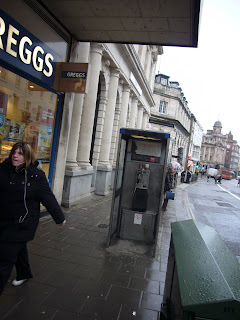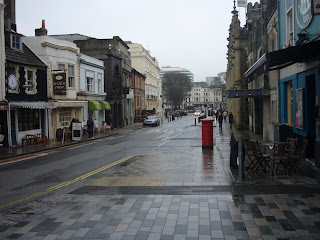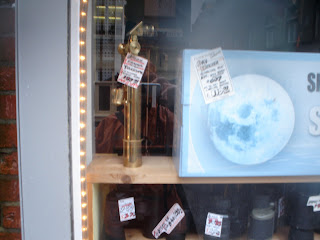Wednesday, 24 February 2010
Mobile Brighton Guide (David)
Weekly Route
It wasn't too easy because it is not automatic as maybe would be tracing the routes with a GPS software...
Here are the results:
PING IMAGE (JUST TRACES)
2D Barcode: Promoting Latin American Poetry
This weeek I created some 2D barcodes using i-nigma. These codes have poetry poems of Mario Benedetti, from Uruguay in English and Spanish. You can red the texts, downloading i-nigma to your mobile to use it as a scanner.
My idea is to do more 2D barcodes related with Latin American poetry and maybe putting them together or distributed in different places... I'm thinking in that.
To see the complete procedure go to: http://themediaexperience.wordpress.com/2010/02/22/read-mario-benedetti-tactics-and-strategy/
Rhythm Stick contact mic

I know this is a dangerous precedent, but I was listening to Andrew last week, and he mentioned that if you take a piezo electric transducer (PZT), wire it up as a contact mic, connect it to a recorder and turn up the volume, then they can be noisy in a musical way.
Tuesday, 23 February 2010
New York
Brighton & Santiago Routes: From train stations to ???
Mapocho Station used to be the main train station of the country and now it is a cultural centre and bar "La Piojera" is one of the most traditional Chilean bars full of tourists and local people.
I decided to work with this map, wondering if I was going to arrive to a bar too in Brighton... so, let's see what happened.
You can compare the area in Brighton and Santiago looking to the photos in each icon.
View Route Santiago-Brighton in a larger map
task for last week

 hello everyone,
hello everyone,





Monday, 22 February 2010
Mapping the Space
 The rules I followed in recreating the maze in Brighton were:
The rules I followed in recreating the maze in Brighton were:Friday, 19 February 2010
Working with processing
Here are the images. I'll try to upload the files.
Thursday, 18 February 2010
mobile processing test
here is the first test of mobile processing to create a mobile visualiser to excite and entertain bored gig watchers.
Wednesday, 17 February 2010
KMZ-CAST
The idea is to enable this file to be downloaded by people to view it on Google Earth. Of course this is a simple trip but with this experiment I can try to make a different map on Google Earth and upload it to my site so people can download it later and maybe learn with it or play.
Press the image to download "Trip from Brighton to London"
Sound-Art

For this weeks experiments I used Processing together with the Ess library to make some art generated dynamically using sound. All of the pieces displayed use FFT to break up the sound into different frequencies and volume level to determine various aspects of the composition. The images presented are snapshots from the applet, which generates fluctuating and shifting imagery depending on the current sound being played.

All of the experiments were variations along the same theme and utilising the same data, however the compositions were altered by changing parameters such as shape primitive, colour, and position of the shapes, allowing them to be controlled by different aspects of the sound input for different effects. A certain degree of randomness was also involved in order to make the images a little more aesthetically interesting. These all take live input sound from the microphone so they are interactive pieces which can be played with and manipulated.

Complete code at-
http://experiments-in-sound-and-vision.blogspot.com/2010/02/sound-art.html
hardware hack part 2

Hi Again,
hardware hacking part 1

Hi,
thought of this as a experiment after an early seminar, where the re-appropriation of hardware in a new case was discussed.
This is a Playstation eyetoy, which uses a standard chip set and can be used with a PC with a logitech driver. This one has been used on a PC for the last 5 years.
The camera is mounted onto a single PCB, and I am looking for an interesting case to fix it into.
Not really mobile, and a bit creepy, depending on what you use the camera for, but I thought I should post it incase it inspired someone else to find a new use for a piece of computer junk you have laying about.
Ru
notes form today's seminar
Monday, 15 February 2010
lost example
This takes the live stream from a video camera, and uses this to plot rectangles which reflect the colours of the stream.
Russell
Analog-Mobile-Music

For one of this weeks experiment I decided to try something out from Nic Collin' book Homemade Electronic Music. Basically I bought a telephone coil from Maplins (£4.99 - looks a bit like a stethescope) which can be used to pick up electro-magnetic radiation given off from circuits and the like, and plugged it into a mini battery powered amplifier in order to sonify the electronic noises and bleeps given off by my mobile phone. I then recorded these into renoise and exported them as a wav.
This experiment interested me as it allowed me to make sounds using my mobile phone in a non-conventional way. Picking up the hidden sounds that the mobile phone gives off, and creating sonic output from usually inaudible sources. The noises made by the mobile phone are always in some sense there, giving off signals which our senses cannot perceive. In this experiment the inaudible, hidden elements of a device, utilised primarily for its audibility, are foregrounded, giving us a new perspective on mobile technology.
Sunday, 14 February 2010
Rhizome - Sampling 1
Sampling #1 (2009) - Eva Paulitsch and Uta Weyrich
By Ceci Moss on Monday, February 8th, 2010 at 2:00 pm.
Since 2006, the two artists have been collecting films from mobile phones in the public sphere. It is the mixture of amateurish documentation of your own life, of a direct, unhampered view on your own reality, of unmotivated, unguided camera movements as the expression of boredom but also of directed little scenarios that aroused our collector's instincts. Paulitsch and Weyrich are accepting all films into their archive uncensored. This is increasingly developing into a fascinating document of our times, to a sort of evidence-gathering on and siting of the present. Above all, however, it resembles a bizarre album of weltering digital imagery.
For the exhibition YOU_ser 2.0 in the ZKM | Media Museum, the two artists make their mobile film archive accessible for visitors via mobile tagging. The mobile films are concealed behind the colourful QR codes, which visitors can decipher with their own WLAN-mobiles or with the mobiles provided by the museum. In this way, the content of the films Paulitsch and Weyrich are collecting on the street and publishing on the Net returns to the private sphere and into the medium where they originate. The video blog serves to show new extracts from this archive and offers a platform to films currently being collected.
Wednesday, 10 February 2010
Google Latitude: Mobile experiment
Well, Monday was a completely mobile day ehehehe, so I decided to try Google Latitude, a Google programme that connects with the GPS of your mobile and register all the places where you are. If you enable that to be public you can share your location with your Google Friends... I tried it and here is the registration of my trip of Monday, from Brighton to London and moving in London.
Followers
Blog Archive
-
▼
2010
(49)
-
▼
February
(33)
- Mobile Brighton Guide (David)
- Weekly Route
- 2D Barcode: Promoting Latin American Poetry
- Rhythm Stick contact mic
- Brighton Grand Prix (Montecarlo) - David
- New York
- Brighton & Santiago Routes: From train stations to...
- Beijing in Brighton
- task for last week
- Mapping the Space
- Working with processing
- mobile processing test
- KMZ-CAST
- Sound-Art
- hardware hack part 2
- hardware hacking part 1
- notes form today's seminar
- lost example
- Analog-Mobile-Music
- Rhizome - Sampling 1
- Google Latitude: Mobile experiment
- CAS Ideas before their time
- Links for presentation Week 5: Spatial Annotation ...
- Decode: A mobile digital experience
- Ringtone game (David)
- Experiments with Mobile Processing (Part 2)
- Experiment with processing
- Experiments with Mobile Processing (Part 1)
- today, I have mostly been looking at flash
- S.O.S.. I need help with GPS
- Interactive Map: Summer Holidays in Chile
- an Alternative to the Keyboard
- Bonnie Mitchell Talk
-
▼
February
(33)




























